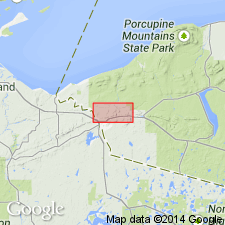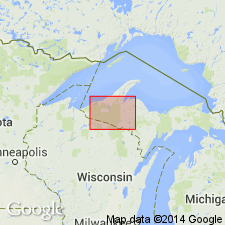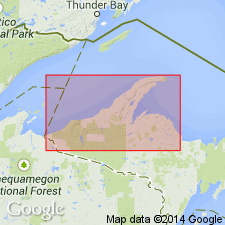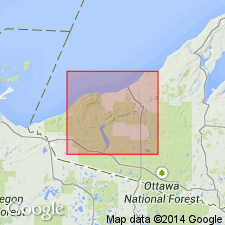
- Usage in publication:
-
- Kallander Creek Formation*
- Modifications:
-
- Named
- Dominant lithology:
-
- Basalt
- Andesite
- AAPG geologic province:
-
- Wisconsin arch
Summary:
Named as formation in Powder Mill Group (new). Named for Kallander Creek, north of Bessemer, Gogebic Co., northwestern MI (upper peninsula). Occurs as a discontinuous band of hills in MI west of Black River and is exposed in stream beds in adjacent WI; no rocks seen east of Black River. Consists of dark-gray, bluish-gray, purple, dark-brown, or reddish-brown, aphanitic or very fine grained or glomeroporphyritic basalt, andesite, and quartz-bearing felsite. Dark-gray to dark-bluish-gray, fine-grained equigranular basalts form lower 800 ft of formation. Differs from underlying Siemens Creek Formation by its lack of chlorite patches. About 4,000 ft exposed in MI, but may be 5,000 ft thickness. Flows range from 30 to 200 ft, average 80 ft. Relation to underlying Siemens Creek is uncertain; bounded by unconformity above. Report includes geologic map and correlation chart. Age is Precambrian Y (middle Keweenawan).
Source: GNU records (USGS DDS-6; Reston GNULEX).

- Usage in publication:
-
- Kallander Creek Formation*
- Modifications:
-
- Revised
- AAPG geologic province:
-
- Wisconsin arch
Summary:
Because the Powder Mill Group and its lower part, the Siemens Creek Formation, are assigned to Keweenawan Supergroup, it is implied that Kallander Creek Formation, the part of Powder Mill Group, is also assigned to Keweenawan Supergroup. Kallander Creek Formation not shown on this map.
Source: GNU records (USGS DDS-6; Reston GNULEX).

- Usage in publication:
-
- Kallander Creek Formation*
- Modifications:
-
- Revised
- AAPG geologic province:
-
- Wisconsin arch
Summary:
Powder Mill Group and its lower Siemens Creek Formation and upper Kallander Creek Formation assigned to Keweenawan Supergroup. Age is Middle Proterozoic. Report includes geologic map and correlation chart.
Source: GNU records (USGS DDS-6; Reston GNULEX).

- Usage in publication:
-
- Kallander Creek Volcanics*
- Modifications:
-
- Revised
- AAPG geologic province:
-
- Wisconsin arch
Summary:
Revised the Kallander Creek to the Kallander Creek Volcanics to maintain consistency with similar Middle Proterozoic continental volcanic sequences in the Lake Superior region.
Source: GNU records (USGS DDS-6; Reston GNULEX).
For more information, please contact Nancy Stamm, Geologic Names Committee Secretary.
Asterisk (*) indicates published by U.S. Geological Survey authors.
"No current usage" (†) implies that a name has been abandoned or has fallen into disuse. Former usage and, if known, replacement name given in parentheses ( ).
Slash (/) indicates name conflicts with nomenclatural guidelines (CSN, 1933; ACSN, 1961, 1970; NACSN, 1983, 2005, 2021). May be explained within brackets ([ ]).

